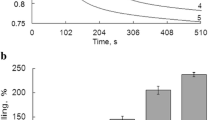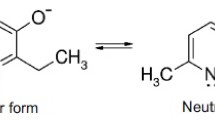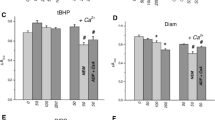Abstract
Alloxan at millimolar concentrations slightly inhibited the velocity of Ca2+ uptake by isolated rat liver mitochondria irrespective of the free Ca2+ concentration between 1 and 10 µM and was an effective concentration-dependent stimulator of mitochondrial Ca2+ efflux. Ninhydrin also slightly inhibited the velocity of mitochondrial Ca2+ uptake but only at free Ca2+ concentrations above 5 µM. However, ninhydrin was a strong stimulator of mitochondrial Ca2+ efflux even at micromolar concentrations, 10–50 times more potent than alloxan. The mitochondrial membrane potential was reduced 10–20% at most by alloxan and ninhydrin. Alloxan and ninhydrin also stimulated Ca2+ efflux from isolated permeabilized liver cells. When isolated intact liver cells had been pre-incubated with alloxan or ninhydrin before permeabilization of the cells the ability of spermine to induce mitochondrial Ca2+ uptake was abolished. Glucose provided the typical protection against the effects of alloxan on mitochondrial Ca2+ transport only in experiments with intact cells but not in experiments with permeabilized cells or isolated mitochondria. Therefore glucose protection is apparently due to inhibition of alloxan uptake into the cell. Glucose provided no protection against effects of ninhydrin under any of the experimental conditions. Thus both alloxan and ninhydrin are potent stimulators of Ca2+ efflux by isolated mitochondria but very weak inhibitors of the velocity of mitochondrial Ca2+ uptake. The direct effects of ninhydrin on mitochondrial Ca2+ efflux may contribute to the cytotoxic action of this agent whereas the direct effects of alloxan on mitochondrial Ca2+ transport require concentrations which are too high to be of relevance for the induction of the typical pancreatic B-cell toxic effects of alloxan. However, the effects on mitochondrial Ca2+ transport during incubation of intact cells which may result from the generation of cytotoxic intermediates during alloxan xenobiotic metabolism may well contribute to the pancreatic B-cell toxic effect of alloxan. Mol Cell Biochem 118: 141–151, 1992)
Similar content being viewed by others
References
Webb JL: Alloxan. In: JL Webb (ed.) Enzyme and metabolic inhibitors. Academic Press, New York, 1966, pp 367–419
McCaldin DJ: The chemistry of ninhydrin. Chem Rev 60: 39–51, 1960
Bolton W: Intermolecular carbonyl carbon-oxygen interactions in organic crystal structures. Nature (London) 201: 987–989, 1964
Schönberg A, Singer E: Die Chemie des Ninhydrins und anderer cyclischer 1,2,3-Tricarbonylverbindungen. Tetrahedron 34: 1285–1300, 1978
Dunn IS, McLetchie NGB: Experimental alloxan diabetes in the rat. Lancet 245(II): 384–387, 1943
Cooperstein SJ, Watkins D: Action of toxic drugs on islet cells. In: SJ Cooperstein, D Watkins (eds) The islet of Langerhans. Academic Press, New York, 1981, pp 387–425
Lenzen S, Panten U: Alloxan: history and mechanism of action. Diabetologia 31: 337–342, 1988
Breton JC, Schmitt H, Neuzil E: Toxicité aiguë de la ninhydrine (hydrate d'indanetrione) pour la souris blanche. C R Soc Biol (Paris) 151: 719–722, 1957
Lenzen S, Munday R: Thiol-group reactivity, hydrophilicity, and stability of alloxan, its reduction products and its N-methyl derivatives and a comparison with ninhydrin. Biochem Pharmacol 42: 1385–1391, 1991
Nelson L, Boquist L: Effects of alloxan and streptozotocin on calcium transport in isolated mouse liver mitochondria. Cell Calcium 3: 191–198, 1982
Boquist L: Alloxan effects on mitochondria in vitro: correlation between endogenous adenine nucleotides and efflux of Ca2+. Biochem Int 9: 637–641, 1984
Boquist L: Alloxan effects on mitochondria: study of oxygen consumption, fluxes of Mg2+, Ca2+, K+ and adenine nucleotides, membrane potential and volume change in vitro. Diabetologia 27: 379–386, 1984
Boquist L: Inhibition by dithioerythritol of alloxan induced efflux of Ca2+ and accompanying alterations in isolated liver mitochondria. Biochem Int 8: 597–602, 1984
Frei B, Winterhalter KH, Richter C: Mechanism of alloxan-induced calcium release from rat liver mitochondria. J Biol Chem 260: 7394–7401, 1985
Lenzen S, Panten U: A versatile Ca2+ ion-sensitive minielectrode with a microincubation chamber. Anal Biochem 149: 301–308, 1985
Lenzen S, Schmidt W, Panten U: Transamination of neutral amino acids and α-keto acids in pancreatic B-cell mitochondria. J Biol Chem 260: 12629–122634, 1985
Becker GL, Fiskum G, Lehninger AL: Regulation of free Ca2+ by liver mitochondria and endoplasmatic reticulum. J Biol Chem 255: 9009–9012, 1980
McKnight GS: A colorimetric method for the determination of submicrogram quantities of protein. Anal Biochem 78: 86–92, 1977
Lenzen S, Panten U: A versatile microfiltration device. Anal Biochem 134: 56–59, 1983
Lenzen S, Hickethier R, Panten U: Interactions between spermine and Mg2+ on mitochondrial Ca2+ transport. J Biol Chem 261: 16478–16483, 1986
Probst I, Unthan-Fechner K: Activation of glycolysis by insulin with a sequential increase of the 6-phosphofructo-2-kinase activity, fructose-2,6-bis-phosphate level and pyruvate kinase activity in cultured rat hepatocytes. Eur J Biochem 153: 347–353, 1985
Lenzen S: Insulin secretion by isolated perfused rat and mouse pancreas. Am J Physiol 236: E391-E400, 1979
Lenzen S, Rustenbeck I: Effects of IP3, spermine, and Mg2+ on regulation of Ca2+ transport by endoplasmic reticulum and mitochondria in permeabilized pancreatic islets. Diabetes 40: 323–326, 1991
Moore CL: Specific inhibition of mitochondrial Ca2+ transport by ruthenium red. Biochem Biophys Res Commun 42: 298–305, 1971
Akerman KEO, Nicholls DG: Physiological and bioenergetic aspects of mitochondrial calcium transport. Rev Physiol Biochem Pharmacol 95: 149–201, 1983
Nicchitta CV, Williamson JR: Spermine; a regulator of mitochondrial calcium cycling. J Biol Chem 259: 12978–12983, 1984
Lehninger AL, Vercesi A, Bababunmi EA: Regulation of Ca2+ release from mitochondria by the oxidation-reduction state of pyridine nucleotides. Proc Soc Acad Sci USA 75: 1690–1694, 1978
Richter C, Frei B: Ca2+ movements accross the inner mitochondrial membrane. In: H Sies (ed) Oxidative Stress. Academic Press, New York, 1985, pp 221–241
Sies H: Hydroperoxides and thiol oxidants in the study of oxidative stress in intact cells and organs. In: H Sies (ed) Oxidative Stress. Academic Press, New York, 1985, pp 73–90
Orrenius S, McConkey DJ, Jones DP, Nicotera P: Ca2+-activated mechanisms in toxicity and programmed cell death. ISI Atlas Sci Pharmacology 319–324, 1988
Boobis AR, Fawthrop DJ, Davies DS: Mechanisms of cell death. Trends Pharmacol Sci 10: 275–280, 1989
Meister A: Glutathione metabolism and its selective modification. J Biol Chem 263: 17205–17208, 1988
Munday R: Dialuric acid autoxidation. Effects of transition metals on the reaction rate and on the generation of ‘active oxygen’ species. Biochem Pharmacol 37: 409–413, 1988
Winterbourn CC, Munday R: Glutathione-mediated redox cycling of alloxan. Mechanisms of superoxide dismutase inhibition and of metal-catalysed OH formation. Biochem Pharmacol 38: 271–277, 1989
Bellomo G, Martino A, Richelmi P, Moore GA, Jewell SA, Orrenius S: Pyridine-nucleotide oxidation, Ca2+ cycling and membrane damage during tert-butyl hydroperoxide metabolism by rat-liver mitochondria. Eur J Biochem 140: 1–6, 1984
Author information
Authors and Affiliations
Rights and permissions
About this article
Cite this article
Lenzen, S., Brünig, H. & Münster, W. Effects of alloxan and ninhydrin on mitochondrial Ca2+ transport. Mol Cell Biochem 116, 141–151 (1992). https://doi.org/10.1007/BF00299393
Received:
Accepted:
Issue Date:
DOI: https://doi.org/10.1007/BF00299393




